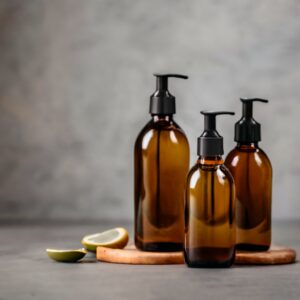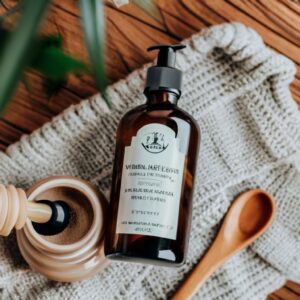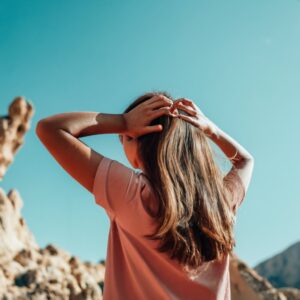
Dealing with head lice can be a real nuisance, causing relentless itching and discomfort. To avoid potential infections, swift action is essential. But how can you effectively get rid of head lice?
Managing these pesky parasites can be quite a task, but there are numerous natural remedies and treatment options that prove effective. In this comprehensive guide, we will explore the best methods for naturally removing and preventing head lice, as well as when it may be necessary to consider medication. Keep reading to find out more.
How to Get Rid of Head Lice

The approach to removing head lice can vary depending on factors such as the infestation severity, skin type, and allergies. Below, we outline one of the simplest methods
Step 1. Check for Head Lice
Most head lice treatments often contain pesticides, and while they are generally safe, it’s wise to use them sparingly. Before proceeding with any treatment, it’s crucial to confirm the presence of head lice and rule out other hair-related issues like dandruff.
Begin by saturating your hair and sit under a bright light source, whether it’s natural sunlight or a well-lit room.
Using a fine-toothed comb, divide your hair into thin sections and closely inspect your scalp. Head lice are typically grayish-brown insects and are relatively easy to spot.
Look for white head lice eggs, also known as nits, which attach themselves to hair strands.
To differentiate lice eggs from dandruff, take a nit or white flake and press it between your gloved fingers. If you hear a faint, sharp sound, it’s likely a lice egg; if not, it’s probably dandruff.
Pinch the hair strand directly beneath the white flake or egg with your fingernails and pull it upward. If it detaches easily, it’s likely dry skin; if not, it’s a lice egg.
Step 2. Shampoo Your Hair
One of the most straightforward ways to treat head lice is by washing your hair with a lice-killing shampoo. These products typically contain mild pesticides that are effective against lice.
If you have identified eggs in your hair, consider using an ovicidal shampoo specially designed to eliminate both lice and their nits.
However, ovicidal shampoos may not be suitable for individuals with:
Dry or flaky scalps
Sensitive scalps with a history of allergies
Injured scalps, particularly those that are bloody or crusty
If you have any of the above issues, consult your doctor before applying any hair product.
Step 3. Remove Lice and Nits
Using a fine-toothed nit comb, divide your hair into small horizontal sections, starting from the crown and working your way to the back of your head.
Run the nit comb through each hair section, removing any dead lice and eggs.
Clean the comb thoroughly between sections.
Repeat this process at least three times before your next hair wash.
Step 4. Repeat the Process
Repeat the shampoo and combing process from the beginning. Remember to wash your clothes after each step to prevent any fallen nits from re-infesting your hair. If the lice persist even after two rounds of treatment, it’s advisable to seek professional medical advice.
Pro Tip: Head shaving is not a recommended solution for lice elimination, as baby lice (nymphs) present on the scalp will eventually mature into adult lice and continue to infest.
While using a delousing shampoo is the most effective method for head lice removal, some individuals may not have immediate access to these products. In the following section, we’ll explore natural ways to get rid of head lice and eggs at home.
Removing Head Lice and Eggs Naturally

Surprisingly, there are several household products that can effectively combat head lice. Here are a few of them:
Anise Oil: Anise oil is known to be effective in eliminating head lice and nits in children. This natural remedy works by suffocating the lice and causing their demise. Additionally, it is believed to act as a preventive measure against head lice and helps deter reinfestation.
Olive Oil: Similar to anise oil, olive oil can also assist in the removal of head lice by suffocating them. It’s an effective, natural approach to preventing reinfestation. For enhanced results, some individuals combine anise and olive oils. Another option is to mix one to two drops of rosemary essential oil with olive oil for head lice treatment.
Coconut Oil: While not as potent as anise or olive oils, coconut oil can still be a valuable solution for dealing with head lice. Research has compared its effectiveness to other over-the-counter medications, with coconut oil showing an 80% effectiveness rate compared to delousing shampoos’ 97.9% effectiveness rate.
Related Article: lice how to get rid of thme ? does coconut oil kill lice?
Now that you have insights into natural head lice remedies, let’s explore medical treatments.
When Is Medication the Most Effective Way to Get Rid of Head Lice?

Currently, delousing shampoos and lotions stand out as the most effective methods for eliminating head lice. Therefore, it is advisable to consider these options before attempting any other home remedy.
There are two primary types of over-the-counter delousing products available:
Pyrethrins Delousing Shampoo: This shampoo contains an extract from chrysanthemum flowers and belongs to a class of medications known as pediculicides. It can be safely used on individuals aged 2 years and older. Typically, this shampoo requires two applications, seven days apart, to ensure the newly hatched lice are also eradicated. It’s important to note that individuals allergic to ragweed and chrysanthemums should avoid this product.
Permethrin Lotion: While Pyrethrins shampoo can eliminate lice, it does not effectively treat their eggs (nits). As an alternative, many people opt for Permethrin Lotion, which not only kills lice but also their nits. It is safe for individuals over 2 months old. This lotion does not wash off easily and leaves residue on the hair, effectively eliminating newly hatched insects and completely eradicating the head lice infestation. However, it’s important to be aware that regular shampoo and conditioner may impact the lotion’s effectiveness, so re-application after 10 days may be necessary.
While both Pyrethrins and Permethrin products are suitable for use on children, doctors often advise against using medical treatments on children under the age of two. In such cases, herbal oils like anise, coconut, and olive oil are recommended for lice elimination.
Related Article: Does mayonnaise kill lice? homemade mayonnaise and lice treatment
Post-Treatment Care for Head Lice

To prevent re-infestation, it’s essential to follow these post-treatment guidelines:
Post-Treatment Care:
Utilize a head lice comb to carefully remove any dead lice or nits approximately 8 hours after applying the treatment.
Ensure that all combs, hair clips, and other hair accessories you use are soaked in boiling water for 5 to 10 minutes. This process guarantees the elimination of any nits.
Wash any clothing you have worn during the infestation in hot water or place them in the washing machine to eliminate nits and any insects that may have fallen onto them.
Refrain from shampooing your hair for 2 to 3 days after using the treatment. This allows the treatment more time to be effective.
Perform routine checks for nits and lice every three weeks. If you happen to find any, take immediate corrective action to prevent re-infestation.
It’s important to keep in mind that while these treatments are effective for many, there may be instances where they don’t yield the desired results. What should you do if that happens?
What If the Treatments Do Not Eliminate Head Lice Quickly?
In some cases, over-the-counter treatments may prove ineffective. This could be due to reasons such as the lice being particularly resilient, improper usage of the treatment, or application at the wrong time. In such situations, it’s advisable to consult your healthcare provider for a basic hair evaluation. They can offer guidance on efficiently eliminating head lice, either by using different over-the-counter treatments or by prescribing stronger medications
Related Article:Does Alcohol Kill Lice and lice egg? What Are The Dangers Related To It?
Preventive Measures for Head Lice

Avoid Sharing Personal Belongings: Lice primarily spread through personal items, especially those used on the head. Therefore, minimize sharing personal belongings with others, including:
- Caps
- Helmets
- Clothing
- Earphones
- Combs and brushes
- Scarves
- Jewelry and hair accessories
Choose Appropriate Hairstyles: Hairstyles that minimize hair-to-hair contact can help prevent lice transmission. Consider braiding your hair and applying styling spray to secure your strands in place.
Regular Hair Oiling: Applying oils like coconut, olive, or anise to your hair can serve as a protective barrier against lice infestation. Regularly oiling your hair may also deter the spread of lice.
Fun Fact: Lice can hold their breath for up to 2 hours.
In summary, head lice are pesky parasites that cause itching due to their bites. There are various effective methods to eliminate head lice, including shampoo treatments, thorough combing, and home remedies like anise oil, olive oil, and coconut oil. Over-the-counter products can also help. To prevent re-infestation and the spread of lice, avoid sharing personal items, use appropriate hairstyles, and regularly oil your hair.
FAQ’s
How do you prevent head lice naturally?
Preventing head lice naturally involves maintaining good hygiene and adopting certain habits. Regularly washing hair with shampoo and conditioner, tying long hair back, avoiding sharing hats, brushes, and other personal items, and discouraging close head-to-head contact can help prevent the spread of lice.
Is there a preventative treatment for head lice?
While there is no foolproof preventative treatment, using tea tree oil-based products or natural repellents may deter lice. Additionally, educating children about the importance of not sharing personal items can significantly reduce the risk of infestation.
How do you stop recurring head lice?
To stop recurring head lice, it’s crucial to identify the source of the infestation and treat it thoroughly. Regularly check your child’s hair, use lice-killing shampoos or treatments as directed, and follow up with combing to remove remaining lice and eggs.
Can you prevent lice with shampoo?
Some shampoos contain ingredients like tea tree oil, which is believed to repel lice. While these products may help deter lice, they are not foolproof preventatives. Maintaining good hygiene practices and avoiding close contact with infested individuals are equally important.
Why am I constantly getting lice?
Frequent exposure to infested individuals or places can lead to recurrent lice infestations. It’s crucial to identify and treat the source of the infestation, thoroughly clean personal items, and follow proper prevention techniques to break the cycle.
Why do I keep getting lice every month?
Persistent lice infestations can occur if all lice and eggs are not effectively removed during treatment. Repeated exposure to infested individuals or items can also contribute. Thoroughly cleaning and disinfecting your home and belongings, in addition to proper treatment, are essential.
What month is lice season?
Lice infestations can occur at any time of the year, but they are more common during the back-to-school season when children are in close contact. However, lice can spread in any season, especially in environments where people share personal items.
What kills lice and eggs instantly?
Products containing pediculicides like permethrin or pyrethrin can kill live lice, but they may not always kill eggs. Comb-out treatments using a fine-toothed comb can help remove live lice and eggs effectively.
Can head lice live on pillows and sheets?
Lice can survive for a short period on bedding items but are generally not likely to infest them. Washing bedding in hot water and drying on high heat can help kill any lice that may be present.
Do I need to wash bedding every day with lice?
While daily washing may not be necessary, washing bedding, hats, and other personal items in hot water and drying them on high heat is recommended after lice exposure. Regularly vacuuming furniture and carpets can also help.
How far can a lice jump?
Lice cannot jump or fly. They crawl from hair to hair, moving from one head to another through direct head-to-head contact or by sharing personal items like hats, combs, or hair accessories.
How long can lice live on a hairbrush?
Lice cannot survive for long without a host. If a hairbrush has lice or nits on it, they are unlikely to survive for more than 24-48 hours away from the scalp.
How do you clean your house after lice?
To clean your house after a lice infestation, wash bedding, hats, and personal items in hot water and dry on high heat. Vacuum furniture, carpets, and any other areas where the infested person has been. Items that cannot be washed can be sealed in plastic bags for a few weeks to suffocate any remaining lice.
What are 4 symptoms of head lice?
Common symptoms of head lice include itching, a tickling feeling of something moving in the hair, irritability, and difficulty sleeping due to scalp discomfort.
What time of year is lice bad?
Lice infestations are more common during the back-to-school season (late summer and early fall) when children return to school and have close head-to-head contact. However, lice can occur at any time of the year.
Can head lice go away on their own?
Lice infestations will not typically go away on their own. Treatment is necessary to eliminate lice and their eggs completely. Without proper treatment, infestations can persist and worsen over time.
How do I know if I have lice?
If you experience persistent itching, a tickling sensation in your hair, or notice small white or yellowish oval eggs (nits) attached to hair strands close to the scalp, you may have lice. It is essential to check for live lice or nits using a fine-toothed comb for a definitive diagnosis.
Does shaving head prevent lice?
Shaving the head can make it more challenging for lice to infest the hair, but it does not guarantee prevention. Lice can still attach themselves to the scalp before the hair grows back.
Why shouldn’t you scratch your head when you have lice?
Scratching the head when you have lice can worsen the irritation and lead to potential skin infections. Additionally, scratching can cause lice or their eggs to transfer to your fingernails, spreading the infestation to other areas of your scalp. It’s essential to avoid scratching and seek proper treatment
